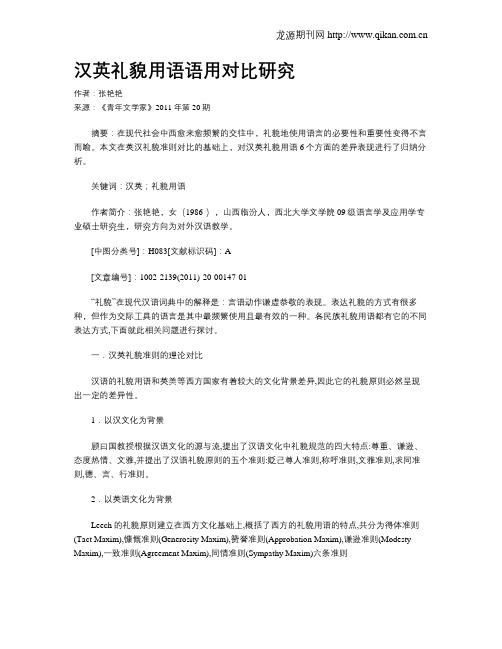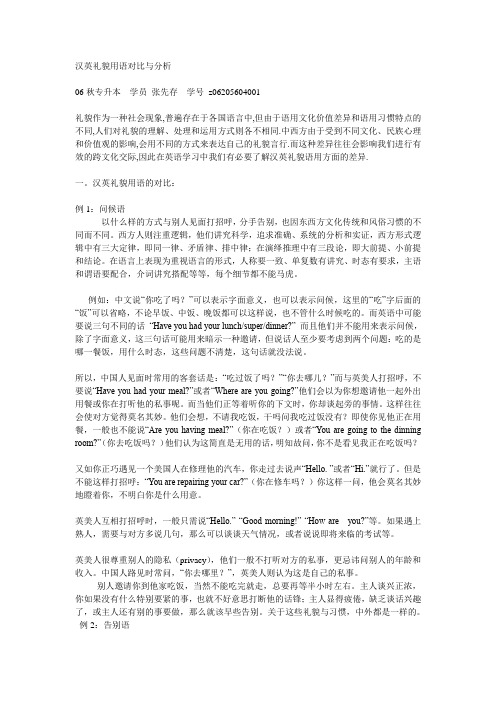汉英礼貌用语对比研究
汉英礼貌用语语用对比研究

汉英礼貌用语语用对比研究作者:张艳艳来源:《青年文学家》2011年第20期摘要:在现代社会中西愈来愈频繁的交往中,礼貌地使用语言的必要性和重要性变得不言而喻。
本文在英汉礼貌准则对比的基础上,对汉英礼貌用语6个方面的差异表现进行了归纳分析。
关键词:汉英;礼貌用语作者简介:张艳艳,女(1986-),山西临汾人,西北大学文学院09级语言学及应用学专业硕士研究生,研究方向为对外汉语教学。
[中图分类号]:H083[文献标识码]:A[文章编号]:1002-2139(2011)-20-00147-01“礼貌”在现代汉语词典中的解释是:言语动作谦虚恭敬的表现。
表达礼貌的方式有很多种,但作为交际工具的语言是其中最频繁使用且最有效的一种。
各民族礼貌用语都有它的不同表达方式,下面就此相关问题进行探讨。
一.汉英礼貌准则的理论对比汉语的礼貌用语和英美等西方国家有着较大的文化背景差异,因此它的礼貌原则必然呈现出一定的差异性。
1.以汉文化为背景顾曰国教授根据汉语文化的源与流,提出了汉语文化中礼貌规范的四大特点:尊重、谦逊、态度热情、文雅,并提出了汉语礼貌原则的五个准则:贬己尊人准则,称呼准则,文雅准则,求同准则,德、言、行准则。
2.以英语文化为背景Leech的礼貌原则建立在西方文化基础上,概括了西方的礼貌用语的特点,共分为得体准则(Tact Maxim),慷慨准则(Generosity Maxim),赞誉准则(Approbation Maxim),谦逊准则(Modesty Maxim),一致准则(Agreement Maxim),同情准则(Sympathy Maxim)六条准则可见,英汉语言的礼貌准则有许多相似之处。
但不同的语言有各自不同的文化背景、衡量标准及表现形式。
事实上礼貌本身既有文化的普遍性,又有明显的文化差异性,这种文化差异常常构成跨文化交际的障碍。
二.汉英礼貌用语的语用差异表现1.称谓语受社会结构、传统伦理、血缘宗族等社会因素的制约,中国社会的称谓语远比英语国家复杂。
英汉礼貌用语对比研究

英汉礼貌用语对比研究学生姓名:周丽平指导老师:王亚琼教学单位:外国语学院摘要:当社会文明达到一定程度,人们在相互交往时十分看重礼貌,东方和西方国家在内涵方面有所差异。
这个课题以英汉礼貌用语以及双方的面子维持和礼貌策略,采用积极礼貌和消极礼貌策略、关联性与独立性等概念,就事论事的分析英汉两种语言在具体的间接言语行为方面的文化差异。
本文从信件为基础,就双方的礼貌策略和面子维持策略,包括感谢、祝贺、以及其他表情性文字等进行详细的分析,并据此来分析翻译中必要的调整。
关键词:礼貌与面子策略;英汉礼貌言语行为对比和翻译一、引言礼貌是文明的象征,在中西国家礼貌运用广泛,但他们之间有鲜明的对比,在运用当中才能体出来。
二、礼貌与面子策略贾玉新以Goffman(1959),Levinson(1983),Scollon和Scollon(1995)的有关理论为依据,认为礼貌是非对称性的,对听话人来讲是礼貌的行为(如祝贺,邀请,感谢),对说话人来讲可能是不礼貌的,即说话人必须有所付出;反之,对说话人有礼貌的(如命令,请示,请求,建议等),对听话人来讲可能不礼貌,构成对听话人面子的威胁。
礼貌概念分为积极礼貌和消极礼貌。
从言语行为来看,积极礼貌可能包括承诺性和表情性言语行为,而消极礼貌则可能包括指示性言语行为,常常涉及到对别人自由的干扰,尽量委婉或策略地表示我们对其他人的尊重。
积极礼貌是“对别人表示赞许”,消极礼貌是“对强加(行为)的回避”。
R.Scollon 和S.W.Scollon在《跨越文化交际一话语分析法》中提到了关联面子(involvement face)和独立面子(independence face)两个原则,一方面我们要参与和别人的活动,并向别人表明我们在参与;另一方面我们要与其它参与者相区别,保持一定程度的独立性。
关联面子强调“平等性”,而独立面子则强调“尊重性”。
这两个方面相悖相反的,却同时发生。
任何交际过程中,说话人和听话人同时面临对自己面子的威胁。
跨文化交际中英汉礼貌用语差异对比研究

跨文化交际中英汉礼貌用语差异对比研究摘要跨文化交际中的礼貌用语是一个非常重要的话题,其涉及到不同语言文化之间的差异。
英汉两种语言文化在礼貌用语方面存在许多差异,例如在称呼方式、道歉方式以及感谢方式等方面。
本文首先探讨了英汉两种语言文化的礼貌用语的概念以及意义,然后分别从称呼方式、道歉方式、感谢方式、客套话等几个方面对英汉两种语言文化的礼貌用语差异进行详细比较,并分析了其背后的文化背景。
最后,提出在跨文化交际中如何避免礼貌用语的误用。
关键词:跨文化交际;礼貌用语;英汉文化差异;称呼方式;道歉方式;感谢方式;客套话AbstractPoliteness language in cross-cultural communication is a very important topic, which involves the differences between different language cultures. There are many differences in politeness language between English and Chinese cultures,such as the way of addressing, apologizing and expressing gratitude. This paper first explores the concept and significance of politeness language in English and Chinese cultures, and then compares the differences in politeness language between English and Chinese cultures in terms ofways of addressing, apologizing, expressing gratitude, and polite language. analyzes the cultural background behind it. Finally, how to avoid the misuse of politeness language in cross-cultural communication is proposed.Keywords: cross-cultural communication; politeness language; English and Chinese cultural differences; ways of addressing; ways of apologizing; ways of expressing gratitude;polite language一、引言随着经济全球化和文化多元化的发展,跨文化交际已成为一种常见的交际方式。
英汉礼貌用语对比研究开题报告

英汉礼貌用语对比研究开题报告英汉礼貌用语对比研究开题报告一、研究背景礼貌用语在交际中扮演着重要的角色,不同语言和文化中的礼貌用语也存在差异。
中英两种语言的礼貌用语存在着许多不同之处,由于文化背景和社会习俗等方面的差异,这些不同之处可能引起交际的不便,因此有必要对这些差异进行研究。
二、研究目的本研究的目的是通过对英汉礼貌用语的对比研究,探讨中英两种语言在交际中的礼貌用语的不同表达方式和应用情况,以期提高跨文化交际能力。
三、研究方法本研究采用对比研究法,即对中英两种语言中的礼貌用语进行对比研究,探讨它们在交际中的使用方式和文化背景等方面的差异。
具体方法包括:1. 收集相关文献资料,对中英两种语言的礼貌用语进行分类整理。
2. 通过对比分析,探究中英两种语言中常用的礼貌用语表达方式的异同。
3. 通过问卷调查等方法,了解不同文化背景下人们对礼貌用语的认知和运用情况。
四、研究内容1. 中英礼貌用语的基本特征中英两种语言的礼貌用语存在着一些基本特征的差异。
中文的礼貌用语通常表现为比较简单的语言形式,而英文的礼貌用语则通常使用比较复杂的语言形式。
例如,在表示感谢的时候,中文通常使用“谢谢”这样的简单语言表达,而英文则可能使用“I really appreciate your help”这样的复杂语言表达。
2. 中英礼貌用语的语言形式中英两种语言中常用的礼貌用语语言形式也存在着差异。
例如,中文中常用的“您好”、“对不起”、“请问”等礼貌用语,在英文中则通常使用“hello”、“sorry”、“excuse me”等表达方式。
3. 中英礼貌用语的运用情况中英两种语言的礼貌用语的运用情况也存在差异。
例如,在商务场合中,中文中的“谈判”可能表示比较强3. 研究方法3.1 数据来源本研究所采用的数据主要来源于现代汉语和英语语料库,包括经典文学作品、报刊杂志、社交媒体等多种文本类型。
通过电子检索工具,收集大量语言数据,并对其进行筛选和分类,以确保数据的质量和有效性。
汉英礼貌用语对比与分析

汉英礼貌用语对比与分析06秋专升本学员张先存学号z06205604001礼貌作为一种社会现象,普遍存在于各国语言中,但由于语用文化价值差异和语用习惯特点的不同,人们对礼貌的理解、处理和运用方式则各不相同.中西方由于受到不同文化、民族心理和价值观的影响,会用不同的方式来表达自己的礼貌言行.而这种差异往往会影响我们进行有效的跨文化交际,因此在英语学习中我们有必要了解汉英礼貌语用方面的差异.一。
汉英礼貌用语的对比:例1:问候语以什么样的方式与别人见面打招呼,分手告别,也因东西方文化传统和风俗习惯的不同而不同。
西方人则注重逻辑,他们讲究科学,追求准确、系统的分析和实证,西方形式逻辑中有三大定律,即同一律、矛盾律、排中律;在演绎推理中有三段论,即大前提、小前提和结论。
在语言上表现为重视语言的形式,人称要一致、单复数有讲究、时态有要求,主语和谓语要配合,介词讲究搭配等等,每个细节都不能马虎。
例如:中文说“你吃了吗?”可以表示字面意义,也可以表示问候,这里的“吃”字后面的“饭”可以省略,不论早饭、中饭、晚饭都可以这样说,也不管什么时候吃的。
而英语中可能要说三句不同的话“Have you had your lunch/super/dinner?” 而且他们并不能用来表示问候,除了字面意义,这三句话可能用来暗示一种邀请,但说话人至少要考虑到两个问题:吃的是哪一餐饭,用什么时态,这些问题不清楚,这句话就没法说。
所以,中国人见面时常用的客套话是:“吃过饭了吗?”“你去哪儿?”而与英美人打招呼,不要说“Have you had your meal?”或者“Where are you going?”他们会以为你想邀请他一起外出用餐或你在打听他的私事呢。
而当他们正等着听你的下文时,你却谈起旁的事情。
这样往往会使对方觉得莫名其妙。
他们会想,不请我吃饭,干吗问我吃过饭没有?即使你见他正在用餐,一般也不能说“Are you having meal?”(你在吃饭?)或者“You are going to the dinning room?”(你去吃饭吗?)他们认为这简直是无用的话,明知故问,你不是看见我正在吃饭吗?又如你正巧遇见一个美国人在修理他的汽车,你走过去说声“Hello. ”或者“Hi.”就行了。
英汉礼貌用语的语用对比

英汉礼貌用语的语用对比英汉礼貌用语是不同文化背景下的表达方式,在语用上会存在一定的差异。
下面将从语境、语调、称谓等方面探讨英汉礼貌用语的语用对比。
首先,在语境上,英汉礼貌用语的应用场景存在差异。
在英语中,礼貌用语通常用于迎接、道别、感谢、请求等场合,以表达尊重和友善。
例如,英语中的"Hello"、"Goodbye"、"Thank you"、"Please"等,是常见的礼貌用语。
而在汉语中,礼貌用语的使用范围更广,除了上述场合外,还用于问候、安慰、祝福等情境。
例如,汉语中的"你好"、"再见"、"谢谢"、"请"等,不仅可以用于平时交流,还可以用于庄重场合,如商务会议、重要场合等。
因此,在语境上,英汉礼貌用语有着一定的差异。
其次,在语调上,英汉礼貌用语也存在差异。
英语中的礼貌用语通常以平和、亲切的语调表达,以显得友好和尊重。
例如,当对方赞美你时,你可以回答"I appreciate your kind words",表达你对对方夸奖的感激之情。
而在汉语中,礼貌用语的语调更多地体现为谦虚、客气、礼貌的方式。
例如,当对方赞美你时,你可以回答"过奖了"或者"不敢当",表达你的谦逊和客气。
因此,在语调上,英汉礼貌用语也有所不同。
最后,在称谓上,英汉礼貌用语存在一定的差异。
在英语中,常见的称谓包括"Mr."、"Mrs."、"Miss"、"Ms."等,用于称呼男性和女性。
同时,也可以用朋友称谓,如"mate"、"buddy"等。
而在汉语中,称谓通常根据年龄、性别和身份来称呼对方,如"先生"、"小姐"、"阿姨"、"师傅"等。
中英礼貌用语差异对比研究毕业论文

毕业设计(论文)题目:中英文化中礼貌语的对比研究A Constructive Study of Politeness in ChineseAnd English Culture学生姓名:蔡美玲学号:0807060128专业班级:B08英语(国际商务)1班指导教师:唐红梅学院:外国语学院2012年4 月中英文化中礼貌语的对比研究摘要语言礼貌是一种普遍的社会现象,广泛地存在于人类社会生活之中。
它协调着人们的社会关系和交际活动,是维系人际和谐的工具,避免交际冲突的手段。
随着中国加入WTO,中国与西方国家在政治,经济,文化方面的联系变得越来越紧密,社交越来越频繁,礼貌用语也显得越来越重要。
在此过程中,言语交际成功与否,在很大程度上取决于能否选用恰当的礼貌表现形式。
本课题将通过对中英文化中礼貌语的对比研究,阐明中西礼貌用语的共性和差异性,以及在不同文化背景下,中英不同的礼貌原则和各自的侧重点。
通过对此课题的研究,使人们在社交过程中,根据不同的场合,正确的使用合适的礼貌语,避免不同文化下不同礼貌用语带来的各种冲突。
同时,能使英语学习者更加透彻的了解西方文化,掌握交际语言。
最后,若用于英语教学中,将提高学生的综合素质,以及跨文化交际能力。
关键词:礼貌用语; 礼貌原则; 文化; 差异对比A CONSTRUCTIVE STUDY OF POLITENESS IN CHINESEAND ENGLISH CULTUREABSTRACTLanguage Courtesy is a kind of common social phenomenon, which widely occurs in the human society of life, coordinating the people's social relationships and communication activity, maintaining interpersonal harmony,and avoiding the communication conflicts. As China entering the WTO and the forming of the globalized market, the relationship between China and the western countries has become closer, with more frequent activities in politics, economy and culture. So language courtesy is taking a more important role in our social life. In this process, the successful cross-cultural communication, to a great extent, depends on the selection of the appropriate politeness. This paper expounds the common features and different courtesy between Chinese and the western through a constructive study of politeness in Chinese and English culture. On the other hand, the paper expounds different politeness principle and the emphasis of the respective in different cultural background.Therefore, the study of this subject can conduct people to use the right polite language, avoiding the conflict that brings about the different culture courtesy and different culture according to the different occasions in the social process. At the same time, the paper can make the reader understand and master the western culture and the right way of communication. Finally, if the politeness principles are used in the English teaching and Learning, it will improve the students' comprehensive quality, and the ability of cross-cultural communication.Key words: polite language; politeness principle; culture;Contents1. Introduction (1)2. Different Principles of Politeness in Chinese and English (1)2.1 Politeness Principles of English (1)2.1.1 Brown and Levinson’s “face” theory (1)2.1.2 Grice Cooperative Principle (2)2.1.3 Leech’s Politeness Principle (2)2.2 Politeness Principles of Chinese (3)3. A Comparison between Chinese and English Politeness (5)3.1 Terms of Address (5)3.2 Humility Language and Formal L anguage (5)3.3 Terms of Privacy (6)3.4 Terms of Greeting (6)3.5 Terms of Thanks (7)3.6 Terms of Goodbye (8)3.7 Terms of Invitation (8)3.8 Differences Politeness of Cooking Culture (8)3.8.1. The Politeness of Atmosphere on T able (8)3.8.2 The Politeness of Customary Actions on T able (9)4. Reasons for the different & countermeasures (9)4.1 Reasons for the Difference (9)4.1.1 Confucianism and Christianity (10)4.1.2 Philosophy D ifferences (10)4.1.3 Differences of Culture, Thinking and V alue (10)4.2 Countermeasures (11)4.2.1 Countermeasures in English teaching (11)4.2.2 Countermeasures in communication (11)5. Conclusion (13)References (14)1.Introduction“As a universal phenomenon, politeness is observed in every society; its main functions are maintaining social order; maintaining friendly interpersonal relations; reducing conflicts and misunderstandings by means of polite speech acts so as to attain the aim of communication.”[1]Both English and Chinese language has much different restriction in the pragmatic, among which the most important is the restriction of cultural factors. British linguists, Leech listed the six politeness principles according to the English culture characteristic, while Gu YueGuo analysed Chinese culture characteristic and had conclude five politeness principles in his work Politeness, Pragmatics and Culture. Comparing the politeness principles of Gu YueGuo and Leech we can find that there are many politeness norms of differences. It is an effective way to prevent pragmatic failures and promote the communication smoothly by analyzing and comparing these differences scientifically.2.Different Principles of Politeness in Chinese and EnglishPoliteness is the common phenomenon existing in social and group which is the symbol of human civilization and the tool of maintaining interpersonal harmony. People should comply with the politeness principles in order to avoid the failures that cause by different politeness 2.1 Politeness Principles of English2.1.1 Brown and Levinson’s “face” theoryPoliteness, in the interaction, can then be defined as the means employed to show awareness of another person’s face. [2]Early in the 1950s, E Goffman, the United States Scholar, had put forward the “Face Behavior T heory”from sociology. Then in 1978, Brown and Levinson had further put forward the “Mature Face T heory”which tried to take face as a common language phenomenon to research on the basis of Goffman in their work of Universals in Language Usage: Politeness Phenomena. The Mature Face Theory of Brown and Levinson is the firsttime to discuss the face problems of politeness systematically from anthropology and philosophy. They thought that face i s ,for every social member ,wanted to gain for the public self-image of them. In the process of interaction, people hope each other can maintain each other's face. Along with the face threat increasing, people use the higher politeness strategies to maintain their face. The face threat level depends on the difference of social distance and social power between the communications.Brown and Levinson divided the face into positive face and negative face. Then politenes s is also divided into the positive manner and negative manner. [3]2.1.2 Grice Cooperative PrincipleGrice, an American linguist, has put forward the Cooperative Principle in people’s conversation. He thought that, “in all the communicati on, the speaker and listener should follow some principles which make the process of communication develop toward the tacit understanding and cooperation. There are four maxims to embody the Cooperative Principle: (1) Quantity Maxim: the information you offer should accord with the conversation, justthe right amount(2). Quality maxim: what you said should be reasonable and true.(3). Relevant maxim: what you said should be related to the content of the front(4). Manner maxim: the word you said should be terse, clear, and systematical. [4]But some people do not comply with this social principle; even some of them violate those in social communication. In other words, the Cooperative Principle can't completely contain the kinds of conversation. According to this, the English linguist Leech thought the root of people violating the Cooperative Principle is that they want to comply with another principles — Politeness Principle. From the Pragmatics and Interpersonal Rhetoric, Leech summed up and classified the Politeness Principle during the social communication. Leech pointed that: the Cooperative Principle guides what we should say, so as to meet the expectations. However, the politeness principle can be maintained the friendship. So the Cooperation Principles and politeness principles can make a supplement each other which restrict people's conversation behaviors.2.1.3 Leech’s Politeness PrincipleEnglish scholar Leech, in his principles of pragmatics, put forward his politeness principle on the basis of Gricean framework. He believed that,”besides Cooperative Principle, Politeness Principle guides and constrains rational people’s conversation as well. It is closelyconnected with Cooperative Principle. Yet on the other hand, it solves the problem why people prefer to use indirect speech in conversation, which cooperative principle can not explain”. Leech’s Politeness Principle is elaborated into six maxims.(1). Maxim of tact: minimize cost to other, maximize benefit to other(2). Maxim of generosity: minimize benefit to yourself, maximize cost to yourself.(3). Maxim of approbation: minimize dispraise to other, maximize praise to other(4). Maxim of modesty: minimize praise of self, maximize dispraise of self,(5). Maxim of agreement: minimize disagreement between self and other; maximizeagreement between self and other.(6). Maxim of sympathy: min imize antipathy between self and other’, maximize s ympathybetween self and other. [5]This is the main content of Leech’s politeness principles. The above criteria have the different emphasis. For example, the maxim of tact and the maxim of generosity, maxim of approbation and maxim of modesty, which is the same, have two different aspects. The maxim of tact is referring to how to treat others which is applied to causative Verbal Behavior “request”. But the maxim of generosity is referring to how to treat self which is applied to commitment Verbal Behavior “promise to help”. Analogously, Approbation maxim is referring to how to treat others while Modesty maxim is referring to how to treat self. The Agreement maxim points out that it is not suitable to express directly the diversity viewpoint with other person. The last maxim, sympathy, stresses out that we should express common mood with others when people are in bad mood.2.2 Politeness Principles of ChineseLike the English speaking countries, the ancient Chinese have made an important discussion on politeness. “道德仁义非礼不成”, “人有礼则安。
中英礼貌用语对比研究 毕业论文

Cultural Differences between Chinese and English on Politeness中英礼貌用语对比研究摘要礼貌是人类文化的普遍现象,广泛的存在于人类社会生活之中,它不仅是人类社会活动的重要准绳,也是人类文明的主要标志。
文明古国中国和西方处于不同的地域,有着不同的文化背景,道德价值观,风土人情等等,中英文化的巨大差异必然导致其礼貌用语的使用差异。
本文将从文化价值角度对中英两种礼貌用语进行对比分析,旨在使交流顺利进行,提高跨文化交际能力。
关键词礼貌用语;英语;汉语;差异对比绪论礼貌作为一种文化习俗,在人脑中是根深蒂固的,它以巨大的力量促使人们按照本民族的习惯进行交际。
即使是许多有文化有教养,知道入乡随俗的人也难以摆脱文化习俗的羁绊,在跨文化交际中有意无意的触犯对方的禁忌,造成语用失误。
跨文化交际中关键性的问题,就是人们能否冲破各自文化的约束去领略认可,或接受其他文化中多重且隐蔽的特性。
为了顺利融洽的进行交际,除了建立良好的习俗差异意识,遵守“入境问禁,入国问俗,入门问佛”的礼仪,规范,更重要的还应重视移情,不管是说话人还是听话人,在认知心理上都要乐于接受对方d 的不同文化,想方设法去理解对方的用意。
在跨文化交流中我们会轻松地发现,英汉两种语言的礼貌用语存在很大的不同,下面我将从以下几个方面进行分析。
一、中英称呼语的文化差异中国人较习惯于非对等式的称呼类型,称呼要讲究“长幼尊卑贵贱”之分,体现出一种权势倾向,是垂直社会关系的标志。
而英语国家受西方文化影响,较崇尚对等式称呼,表现出平等的文化取向 。
(一)、姓名。
比如,在中国,下属不能叫上司的名字,学生不能直接叫老师的名字,孩子不能直呼父母的名字。
否则就会被认定为没有礼貌,缺乏教养。
而英语文化中的称呼语注重双方亲近,表现出平等的文化取向。
在英语国家,一般来说,不论对方年龄多大,地位和级别多高,人们更愿意直呼其名,以示亲近。
- 1、下载文档前请自行甄别文档内容的完整性,平台不提供额外的编辑、内容补充、找答案等附加服务。
- 2、"仅部分预览"的文档,不可在线预览部分如存在完整性等问题,可反馈申请退款(可完整预览的文档不适用该条件!)。
- 3、如文档侵犯您的权益,请联系客服反馈,我们会尽快为您处理(人工客服工作时间:9:00-18:30)。
汉英礼貌用语对比研究一、引言礼貌是各种文化普遍存在的一种社会现象。
礼貌用语是人们日常语言交际过程中的重要手段,不同的文化背景下有着不同的礼貌用语。
恰当使用礼貌用语,对调和及融洽人际关系起到了意想不到的作用。
二、本论(一)“礼貌”概念的不同渊源1.汉文化中的“礼貌”概念的历史渊源.汉文化中“礼貌”概念的历史渊源礼貌具有普遍性,但不同文化在实现礼貌的方法以及在礼貌的判断标准上存在着差异。
这些差异是在社会、历史、人文、地理等多种因素的长期影响下逐步形成的。
首先,汉英文化中礼貌概念的渊源有所不同。
汉文化中现代的“礼貌”概念有着悠久的历史渊源,它起源于古代的“礼”,即礼制。
众所周知,礼是中国古代哲学思想的一个重要组成部分,也是儒家思想的重要概念之一。
孔子生活的春秋末期,诸侯争霸,统治者内部矛盾重重,战争不断,社会动荡。
孔子为了适应当时的社会生活的要求,致力于恢复“礼制”,以便使社会平稳地过渡到一个新的“天下有道”的社会。
孔子的“礼”并不指“礼貌”,而是指自奴隶社会时期的周朝(公元前1100年)以来的社会等级秩序。
通过“正名”,“礼”规定了社会成员之间的等级差别,要求每个社会成员按照自己的社会地位来说话、做事。
在《论语·子路》中,孔子指出:“名不正则言不顺,言不顺则事不成,事不成则礼乐不兴,礼乐不兴则刑罚不中,刑罚不中则民无所措手足”。
因此,“正名”就是要维护君君、臣臣、父父、子子等的等级关系,这种关系在某种程度上是通过语言来实现的。
《荀子·礼论》也谈到了礼的起源(当然说的是礼制):“人生而有欲,欲而不得,则不能无求;求而无度量分界,则不能不争;争则乱,乱则穷。
先王恶其乱也,故制礼义以分之,以养人之欲,给人之求,使欲不穷乎物,物必不屈于欲,两者相持而长,是礼之所起也”,“也就是说,礼起源于人类欲望与欲望的难以满足之间的不平衡”[1],因此,无论是孔子还是荀子,都把“礼”看成是维护现行社会等差的行为法则,只要人人遵守“礼”,既定的社会秩序就不会打乱;相反,若违反“礼”,就会受到惩罚。
在孔子之后的二、三百年,礼制已完全建立起来。
但后来孔子的“礼”的概念发生了变化,已接近现代意义的“礼貌”概念。
西汉戴申所编《礼记》中的重要论述:“勿不敬。
夫礼者,自卑而尊人”,表明那时“礼”的概念已包含“尊敬”、“敬意”这些现代“礼貌”概念的要素。
而且《礼记》中所表述的贬己尊人,正是汉文化中礼貌的一大特点。
因此,汉文化中现代“礼貌”概念的悠久的历史渊源决定着它与英语文化中“礼貌”概念在内涵上完全不同。
2.英语文化中的“礼貌”概念的历史渊源2.英语文化中“礼貌”概念的渊源礼貌作为一种各社会各群体共有的普遍现象,在英语文化中也能找到其渊源。
英语文化中“礼貌”概念的产生和演变,也经历了不断的变化。
在英语中“礼貌”(politeness)是和“宫廷”(court)及“城市”(city)联系在一起的。
首先,从词源上说,“politeness”和“polite”都与词根“polis,polit”有直接联系,这两个词根由希腊词根“polis”和“politeia”派生而来,而这两个希腊词根就指城市或城市的管理(city or government of city)。
其次,英语中polite的同义词有courteous,urbane和civil。
这些词原本都用来指宫廷中或城市中人们良好的言行举止。
何兆熊指出:“不少学者的研究结果已证明礼貌和宫廷及城市之间的词汇上的联系。
历史上某个时期城市中人们的行为被认为是礼貌的,而另一个时期宫廷中人们的行为被认为是礼貌的。
”[2]如上所述,汉英两种文化中,“礼貌”的渊源迥然不同,这种差异必将导致“礼貌”的内涵不同,人们所遵循的礼貌原则及准则也不同。
(二)文化差异文化差异,本文主要指跨语言,跨文化交际中出现的中英文化差异。
不同的文化就会导致不同的生活习惯,在不同的生活习惯上礼貌语言也就会出现很大的差异。
文化的不同带来价值观念的在不相同。
如lod一词,中国人历来就有“尊老敬老”的传统。
“老”在中文里表达尊敬的概念,如老祖宗,老爷爷,老先生等。
“老张”,“老王”,透着尊敬和亲热,“张老”“王老”更是尊崇有加。
中国人往往以年龄大为荣。
和别人谈话时,年龄越大,资格越老,也就越会得到别人的尊敬。
“姜还是老的辣”。
在我们看来,长者不仅是智慧的化身,也是威望的象征。
然而,西方国家极少有人愿意倚老卖老而自称”old”。
在他们看来,“old”是“不中用”的代名词,是和“不合潮流”“老而无用”的含义连在一起的。
英美人不喜欢别人说自己老,更不会倚老卖老。
在西方文化中,他们把年龄作为个人极为重要的隐私看待。
尤其是女士,更忌讳别人问自己的年龄。
即使愿意谈论自己的年龄,也要别人猜测其年龄,而此时,他们的真正目的的期望别人恭维他们看上去比实际年龄小,是多么年轻。
又如,英美人忌讳莫深的fat一词,见人说fat会令人沮丧不快而且反感。
说到fatmeat(肥肉)多半会被认为是毫无价值的该扔掉的废物。
而中国人见了小孩子说“胖嘟嘟”“胖乎乎”,表示对孩子的喜爱,对成年男子说fat有“发福”之义,对成年女子讲fat有“丰满”之义,都有赞美恭维之意。
日常生活工作中,也经常听到人们说某种东西是块“肥肉”或某差使是个“肥缺”的话语,言下之意是不可多得的东西或是求之不得的位置。
中国人不但不讨厌fat,而且对其赞美有加。
同样的一件事物,不同的文化背影,看法大相径庭。
中国人蔑视狗,因而有“走狗”“狗腿子”“狗东西”“赖皮狗”“狗急跳墙”“狗仗人势”“狗眼看人低”等说法。
而在西方国家,人们则欣赏狗的勇敢和忠诚,对狗的赞誉也屡见不鲜,并把人比作狗。
如aluckdog(幸运儿),loveme,love my dog(爱屋及乌),Every dog has his day.(凡人皆有得意日)。
形容人“病得厉害”用sickas a dog.。
“累极了”是dog—tired.与此相反,中国人十分喜爱猫,用“馋猫”比喻人贪嘴,常有亲昵的成份,而在西方文化中,“猫”被用来比喻“包藏祸心的女人”。
中西方的文化差异除了表现在价值观,习俗差异等外,还与生存环境,宗教信仰,历史典故的不同有关。
1、生存环境方面:语文的产生与人们的劳动和生活密切相关。
英国是一个岛国,历史上航海业曾一度领先世界;而汉民族在亚洲大陆生活繁衍,人们的生活离不开土地。
比喻花钱浪费,大手大脚,英语是spend money like lvater,而汉语是“挥金如土”。
英语中有许多关于船和水的习语,在汉语中没有完全相同的对应习语,如to rest on one’s oars(暂时歇一歇),to keep one’s head above water(奋力图存),all at sea(不知所措)等等。
在汉语的文化氛围中,“东风”即是“春天的风”,夏天常与酷暑炎热联系在一起,“赤日炎炎似火烧”,“骄阳似火”是常被用来描述夏天的词语。
而英国地处西半球,北温带,海洋性气候,报告春天消息的却是西风,英国著名诗人雪莱的《西风颂》正是对春的讴歌。
英国的夏季正是温馨宜人的季节,常与“可爱”“温和”“美好”相连。
莎士比亚在他的一首十四行诗中把爱人比作夏天,shall I compare thee to a summer’s day?/Thou art more lovely and more temperate.2、宗教信仰方面佛教传入中国已有一千多年的历史,人们相信有“佛主”在左右着人世间的一切,与此有关的语言很多,如“借花献佛”“闲时不烧香,临时抱佛脚”等。
在西方许多国家,特别是在英美,人们信奉基督教,相关的有“God helps those who help themselves(上帝帮助自助的人)”Go to hell(下地狱吧)这样的诅咒。
3、历史典故方面英汉两种语文中有大量的由历史典故形成的。
这些习语结构简单,意义深远,往往是不能单从字面意义去理解和翻译。
如“东施效颦”“名落孙山”“叶公好龙”等等。
英语中Achilles’heel(唯一致使弱点),meet one’s waterloo(一败涂地),Penelope’s web (永远完不成的工作),a pandora’s box.。
(潘多拉之盒――灾难,麻烦,祸害的根源)等。
由于各种各样的原因,导致了中西方有诸如此多的文化差异,而文化差异又是跨文化交际的障碍,所以搞清楚它们之间的差异是非常重要的。
如下对汉英礼貌的差异进行了略微对比。
(三)礼貌用语差异因为汉英“礼貌”概念的历史渊源不尽相同,同时汉英文化差异也很大,所以在不同场合,不同社会背景和文化的人会话时所采用的表达方式不尽相同,礼貌用语也有天壤之别。
下面主要从称呼语、致谢语与道歉语、禁忌语与委婉语、恭维语和自谦语等方面来谈谈英汉礼貌用语的差异。
1.称呼语的不同;不同的称呼语体现了不同的民族文化,反映了不同的文化取向、社会格局、人际关系等。
中国素以“礼仪之邦”甲天下,一直遵循“上下有礼,长幼有序”称呼原则,称呼繁杂;而西方崇尚民主自由,称呼简单明了。
中国文化主张尊老讲辈分,各种称呼五花八门。
上辈直系亲属的称呼就有“舅舅”、“伯父”、“叔父”、“姨父”、“姑父”、“舅妈”、“姨妈”、“姑妈”等。
同辈中则有“堂哥”、“堂弟”、“堂姐”、“堂妹”、“表哥”、“表弟”、“表姐”、“表妹”。
在英语国家中,由于不同的价值观念,亲属的称谓比较笼统且简单,上一辈中只有“uncle”、“aunt”,在同辈中也只有一个“cousin”。
晚辈和长辈之间、同辈之间都可以直呼对方的名字,甚至对父母也可直呼其名。
而在中国传统教育中,孩子不能直呼父母、长辈的大名,学生不可直接叫老师的名字,下属不能直接叫上司的名字。
否则,就会被视作缺少家教、没有教养、不守规矩等。
在社会交往中,汉语称呼语可用两种表达式来概括:“姓氏+官衔或职务/先生/女士//小姐/老”和“老/小、+姓氏”,如“张局长”、“王先生”、“郑老”、“老陈”等。
同样的称呼语套用到英语中去,就可能是无礼、奇怪的,甚至适得其反。
若称呼一位上了年纪的美国老先生为“爷爷”则可能会引起老先生的不满而导致交际的失败。
英语中称呼语常用的表达式则可归纳为:“Mr./Mrs/Ms+姓名”、“头衔(Dr./Prof.等)+姓名”、直名称呼、专f-j,g谓(Sir,Madam等)。
尤其是近年来,西方社会交往中的“称呼”似乎正在经历一场革命,不论地位和职位高低,人们越来越愿意直呼其名了。
这似乎意味着人际关系越来越趋于平等了。
2.致谢与道歉语的不同;致谢语也是一种礼貌语言。
当别人为自己花费了精力和时间,付出了一定的劳动或在物质上提供了方便,在精神上给予了大力支持和帮助自己解决了困难时,往往要向对方表示感谢,这种感谢的话语就是致谢语。
